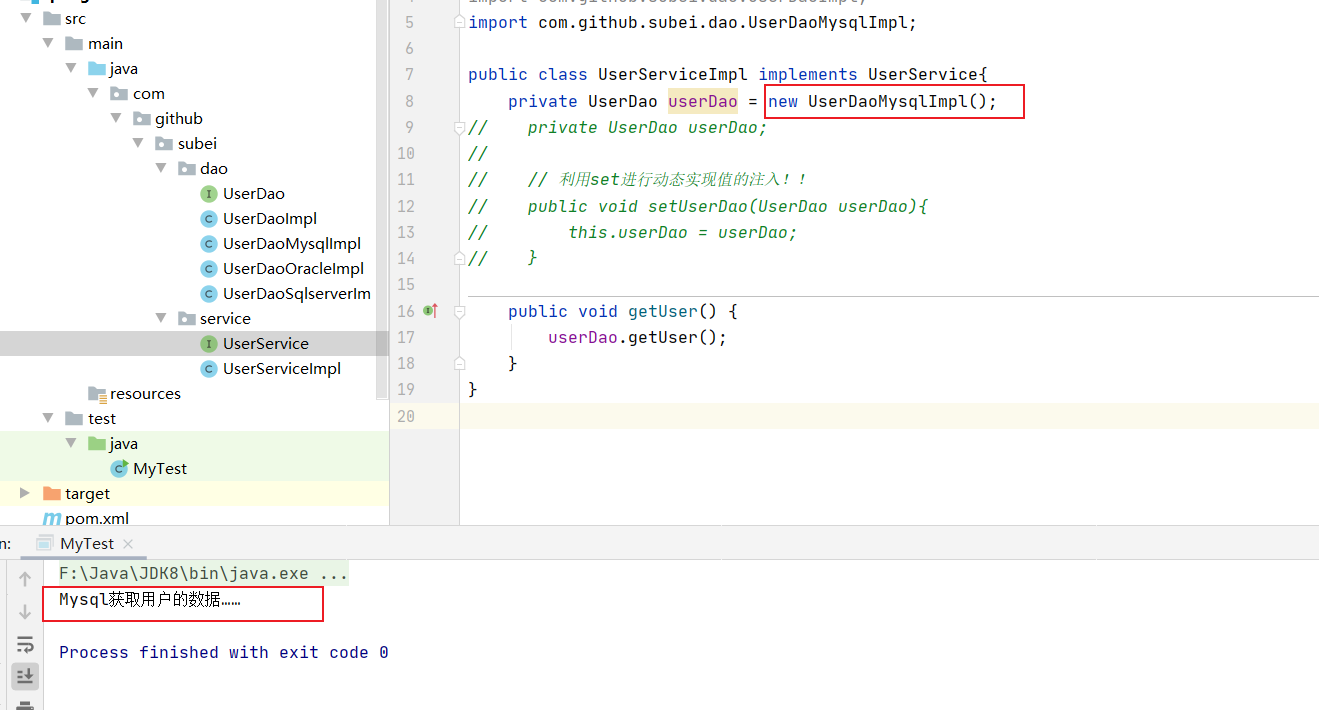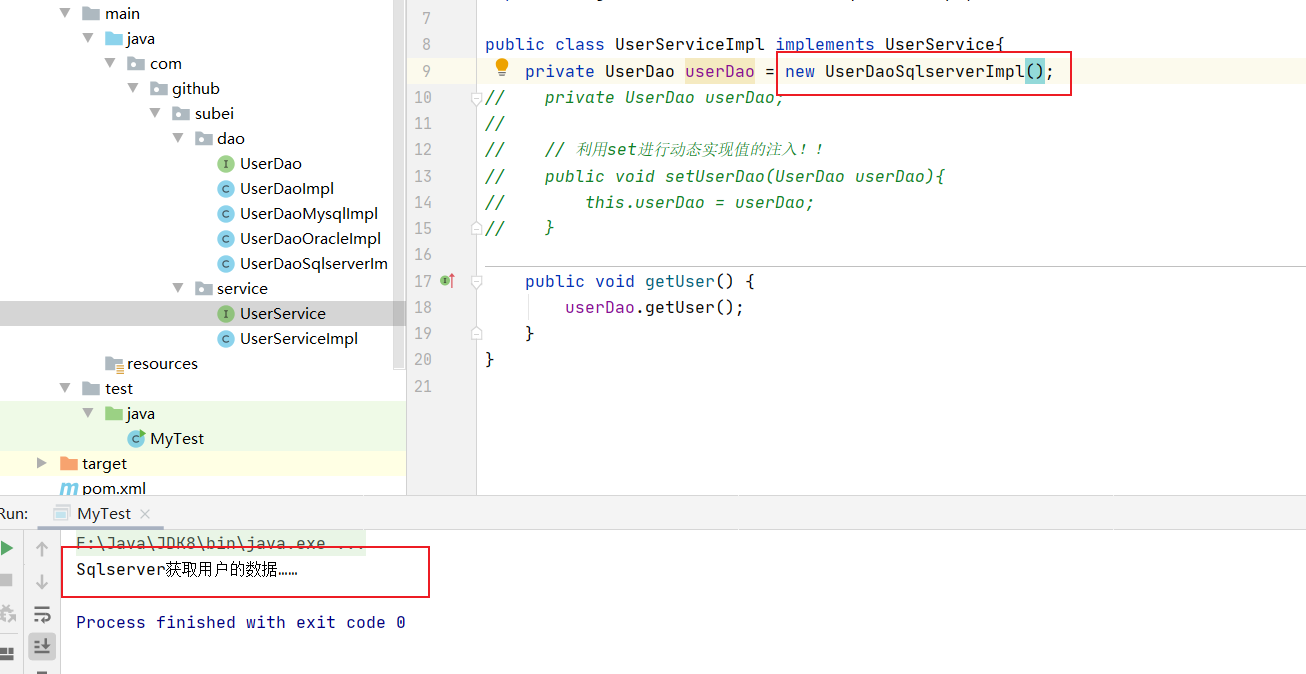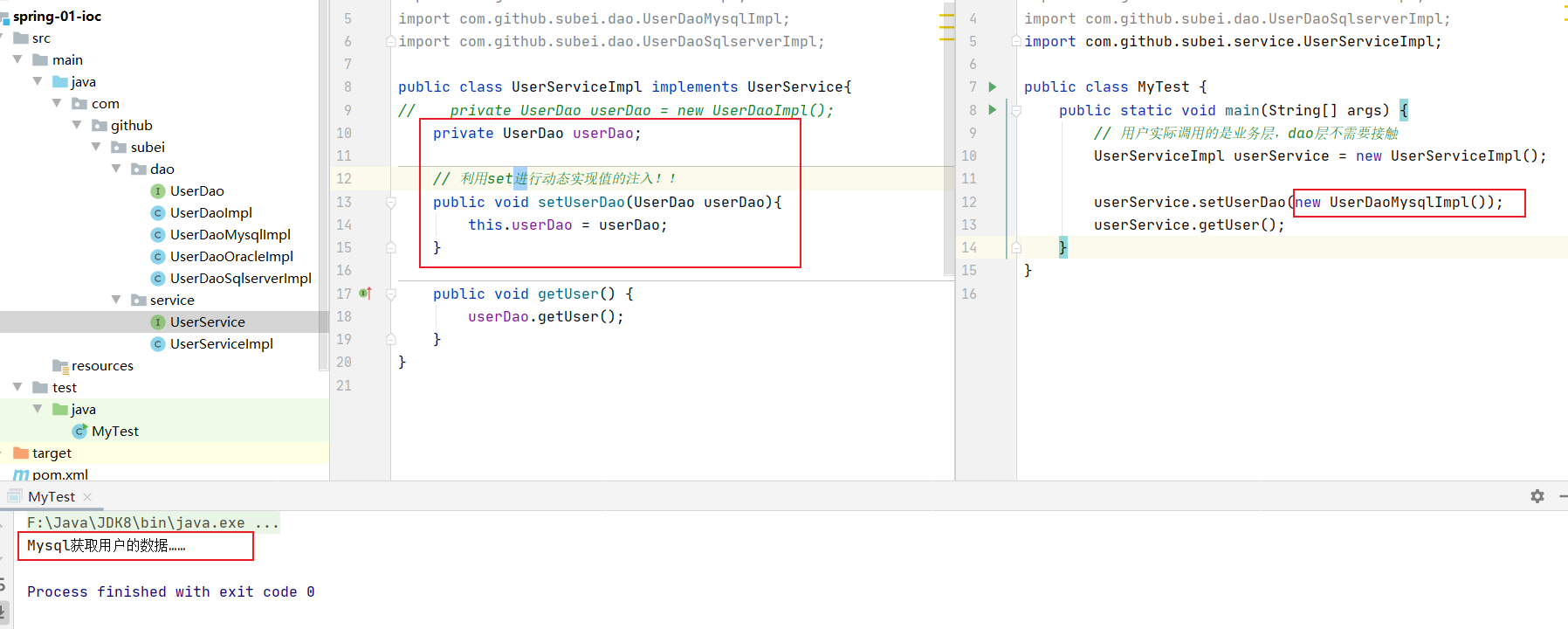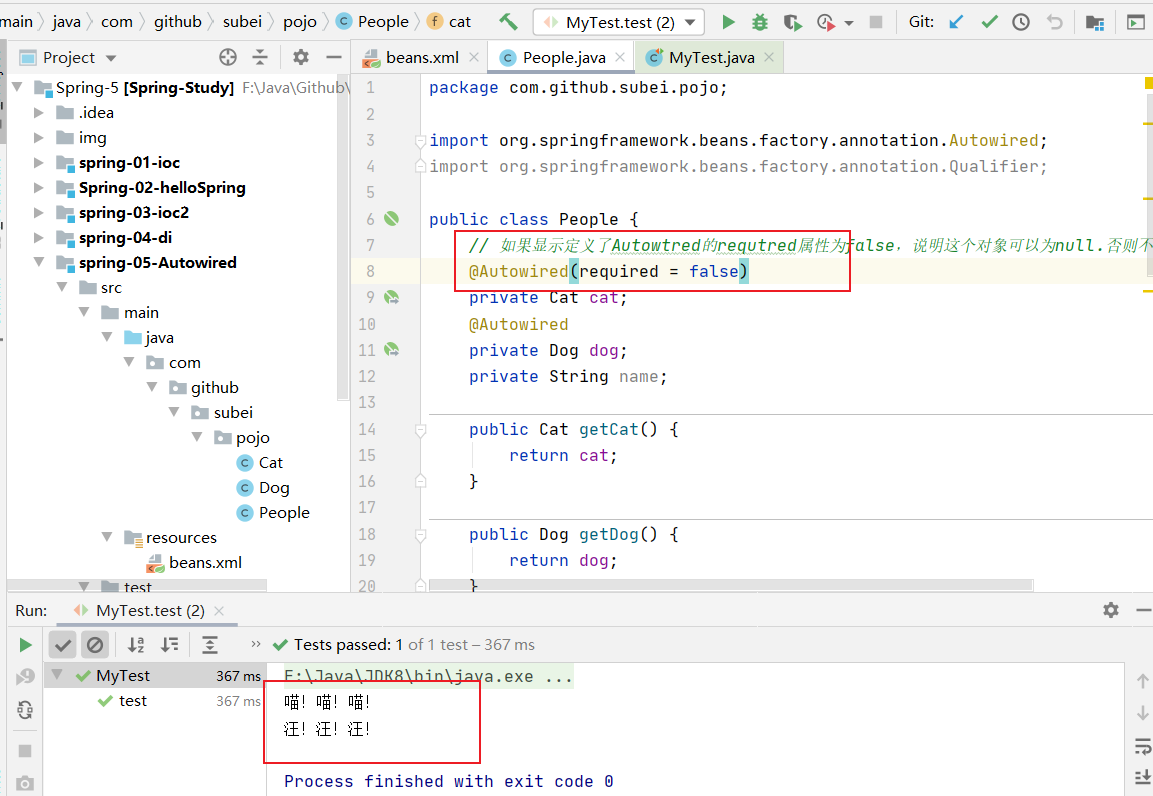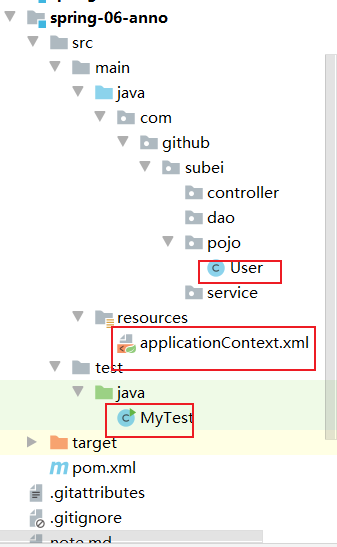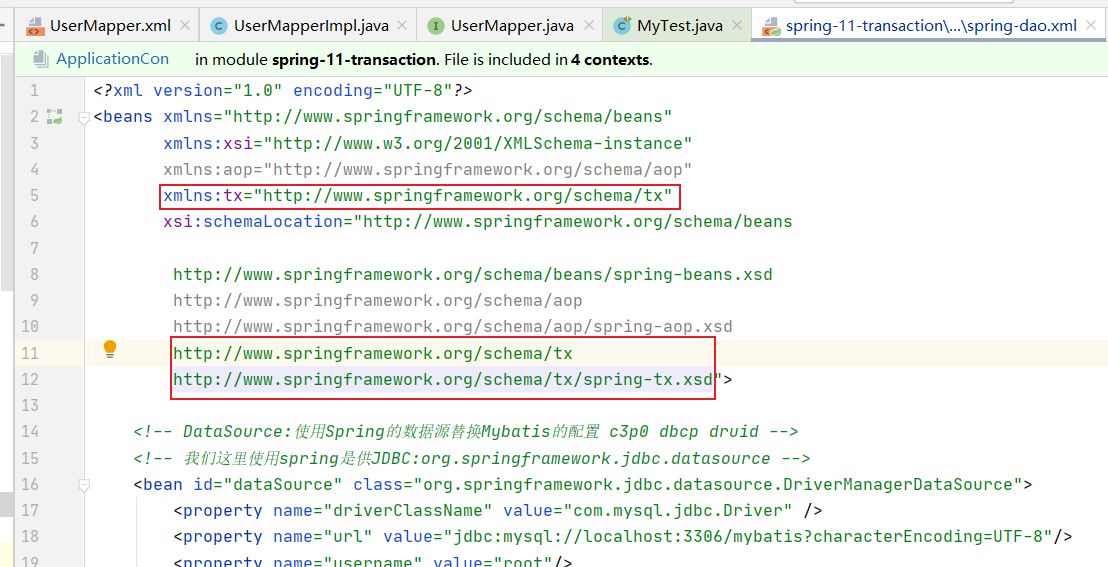Spring 1、Spring 1.1 简介 Spring :春天 ——> 软件行业带来春天2002,首次推出了Spring了框架 的雏形:interface21框架 ! Spring框架即以interface21框架为基础,经过重新设计,并不断丰富其内涵,于2004年3月24日,发布了1.0正式版。 Rod Johnson ,Spring Framework创始人,著名作者。很难想象Rod Johnson的学历,真的让好多人大吃一惊,他是悉尼大学 的博士,然而他的专业不是计算机,而是音乐学。Spring理念:使现有的技术更加容易使用,本身是一个大杂烩;整合了现有的技术框架。 SSH:Struct2 + Spring + Hibernate! SSM:SpringMVC + Spring + Mybatis! 官网:https://spring.io/projects/spring-framework#overview 官方下载地址: http://repo.spring.io/release/org/springframework/spring 官方文档:https://docs.spring.io/spring-framework/docs/current/reference/html/core.html 中文版官方文档:https://www.docs4dev.com/docs/zh/spring-framework/5.1.3.RELEASE/reference 1 2 3 4 5 6 7 8 9 10 11 12 13 <dependency > <groupId > org.springframework</groupId > <artifactId > spring-webmvc</artifactId > <version > 5.2.12.RELEASE</version > </dependency > <dependency > <groupId > org.springframework</groupId > <artifactId > spring-jdbc</artifactId > <version > 5.2.12.RELEASE</version > </dependency >
1.2 优点 Spring是一个开源免费的框架(容器)! Spring是一个轻量级的、非入侵式的框架! 控制反转(IOC),面向切面编程(AOP)! 支持事务的处理,对框架整合的支持! 总结:==Spring就是一个轻量级的控制反转(IOC)和面向切面编程(AOP)的框架==。
1.3 组成 参考:https://docs.spring.io/spring-framework/docs/4.2.x/spring-framework-reference/html/overview.html
Spring 框架是一个分层架构,由 7 个定义良好的模块组成。
1.4 拓展
Spring Boot一个快速开发的脚手架。 基于Spring Boot 可以快速开发单个微服务。 约定大于配置! Spring CloudSpring Clound 是基于Spring Boot 实现的。 为什么要学Spring?
因为:现在大多数公司都在使用 Spring Boot 进行快速开发,学习 Spring Boot 的前提,需要完全掌握 Spring 及 Spring MVC!承上启下的作用!
弊端:发展了太久之后,违背了原来的理念!配置十分繁琐,人称:“配置地狱!”。
2、IOC理论推导 2.1 引例 先构建下图基本框架,并导入maven环境文件。
UserDao 接口
1 2 3 4 5 package com.github.test.dao;public interface UserDao { void getUser () ; }
UserDaoImpl 实现类
1 2 3 4 5 6 7 package com.github.test.dao;public class UserDaoImpl implements UserDao { public void getUser () { System.out.println("默认获取用户的数据……" ); } }
UserService 业务接口
1 2 3 4 5 package com.github.test.service;public interface UserService { void getUser () ; }
UserServiceImpl 业务实现类
1 2 3 4 5 6 7 8 9 10 11 12 package com.github.test.service;import com.github.test.dao.UserDao;import com.github.test.dao.UserDaoImpl;public class UserServiceImpl implements UserService { private UserDao userDao = new UserDaoImpl (); public void getUser () { userDao.getUser(); } }
测试类MyTest
1 2 3 4 5 6 7 8 9 10 import com.github.test.service.UserServiceImpl;public class MyTest { public static void main (String[] args) { UserServiceImpl userService = new UserServiceImpl (); userService.getUser(); } }
在我们之前的业务中,用户的需求可能会影响我们原来的代码,我们需要根据用户的需求去修改原代码!如果程序代码量十分大,修改一次的成本十分昂贵。
我们使用一个set接口实现。修改UserServiceImpl.java文件 1 2 3 4 5 6 7 8 9 10 11 12 13 14 15 16 17 package com.github.test.service;import com.github.test.dao.UserDao;public class UserServiceImpl implements UserService { private UserDao userDao; public void setUserDao (UserDao userDao) { this .userDao = userDao; } public void getUser () { userDao.getUser(); } }
1 2 3 4 5 6 7 8 9 10 11 12 import com.github.test.dao.UserDaoSqlserverImpl;import com.github.test.service.UserServiceImpl;public class MyTest { public static void main (String[] args) { UserServiceImpl userService = new UserServiceImpl (); userService.setUserDao(new UserDaoSqlserverImpl ()); userService.getUser(); } }
之前,程序是主动创建对象!控制权在程序猿手上! 使用了set注入后,程序不再具有主动性,而是变成了被动的接受对象! 这种思想,从本质上解决了问题,我们程序猿不用再去管理对象的创建了。系统的耦合性大大降低,可以更加专注的在业务的实现上!==这是IOC的原型==。
2.2 IOC的本质 控制反转loC(Inversion of Control),是一种设计思想,DI(依赖注入)是实现loC的一种方法 ,也有人认为DI只是loC的另一种说法。没有loC的程序中,我们使用面向对象编程,对象的创建与对象间的依赖关系完全硬编码在程序中,对象的创建由程序自己控制,控制反转后将对象的创建转移给第三方,个人认为所谓控制反转就是:获得依赖对象的方式反转了。
采用XML方式配置Bean的时候,Bean的定义信息是和实现分离的,而采用注解的方式可以把两者合为一体,Bean的定义信息直接以注解的形式定义在实现类中,从而达到了零配置的目的。 控制反转是一种通过描述(XML或注解)并通过第三方去生产或获取特定对象的方式。在Spring中实现控制反转的是IoC容器,其实现方法是依赖注入(Dependency Injection,DI)。 3、HelloSpring 新建项目,导入Jar包
注 : spring 需要导入commons-logging进行日志记录 . 利用maven , 它会自动下载对应的依赖项。 1 2 3 4 5 6 7 <dependencies > <dependency > <groupId > org.springframework</groupId > <artifactId > spring-webmvc</artifactId > <version > 5.2.12.RELEASE</version > </dependency > </dependencies >
编写代码:
编写一个Hello实体类 1 2 3 4 5 6 7 8 9 10 11 12 13 14 15 16 17 18 19 20 package com.github.test.pojo;public class Hello { private String src; public String getSrc () { return src; } public void setSrc (String src) { this .src = src; } @Override public String toString () { return "Hello{" + "src='" + src + '\'' + '}' ; } }
编写spring文件 , 这里命名为beans.xml 1 2 3 4 5 6 7 8 9 10 11 12 <?xml version="1.0" encoding="UTF-8" ?> <beans xmlns ="http://www.springframework.org/schema/beans" xmlns:xsi ="http://www.w3.org/2001/XMLSchema-instance" xsi:schemaLocation ="http://www.springframework.org/schema/beans http://www.springframework.org/schema/beans/spring-beans.xsd" > <bean id ="hello" class ="com.github.test.pojo.Hello" > <property name ="src" value ="Spring" /> </bean > </beans >
3、我们可以去进行测试了 .
1 2 3 4 5 6 7 8 9 10 11 12 13 import com.github.test.pojo.Hello;import org.springframework.context.ApplicationContext;import org.springframework.context.support.ClassPathXmlApplicationContext;public class MyTest { public static void main (String[] args) { ApplicationContext context = new ClassPathXmlApplicationContext ("beans.xml" ); Hello hello = (Hello) context.getBean("hello" ); System.out.println(hello.toString()); } }
思考:
Hello 对象是谁创建的 ? Hello 对象的属性是怎么设置的 ?hello 对象的属性是由Spring容器设置的。 这个过程就叫控制反转:
控制 : 谁来控制对象的创建 , 传统应用程序的对象是由程序本身控制创建的 , 使用Spring后 , 对象是由Spring来创建的。 反转 : 程序本身不创建对象 , 而变成被动的接收对象。 依赖注入 : 就是利用set方法来进行注入的。
修改案例一:
在案例一中, 新增一个Spring配置文件beans.xml 1 2 3 4 5 6 7 8 9 10 11 12 13 14 15 16 17 18 <?xml version="1.0" encoding="UTF-8" ?> <beans xmlns ="http://www.springframework.org/schema/beans" xmlns:xsi ="http://www.w3.org/2001/XMLSchema-instance" xsi:schemaLocation ="http://www.springframework.org/schema/beans http://www.springframework.org/schema/beans/spring-beans.xsd" > <bean id ="mysqlImpl" class ="com.github.test.dao.UserDaoMysqlImpl" /> <bean id ="oracleImpl" class ="com.github.test.dao.UserDaoOracleImpl" /> <bean id ="UserServiceImpl" class ="com.github.test.service.UserServiceImpl" > <property name ="userDao" ref ="mysqlImpl" /> </bean > </beans >
1 2 3 4 5 6 7 @Test public void test2 () { ApplicationContext context = new ClassPathXmlApplicationContext ("beans.xml" ); UserServiceImpl serviceImpl = (UserServiceImpl) context.getBean("UserServiceImpl" ); serviceImpl.getUser(); }
==OK , 到了现在 , 彻底不用再程序中去改动了 , 要实现不同的操作 , 只需要在xml配置文件中进行修改 , 所谓的IoC,一句话搞定 : 对象由Spring 来创建 , 管理 , 装配 !== 4、IOC创建对象方式 4.1 方式一 方式一:通过无参构造方法来创建。
User.java 1 2 3 4 5 6 7 8 9 10 11 12 13 14 15 16 17 18 19 20 21 package com.github.test.pojo;public class User { private String name; public User () { System.out.println("User的无参构造!" ); } public String getName () { return name; } public void setName (String name) { this .name = name; } public void show () { System.out.println("name=" + name ); } }
beans.xml 1 2 3 4 5 6 7 8 9 10 11 <?xml version="1.0" encoding="UTF-8" ?> <beans xmlns ="http://www.springframework.org/schema/beans" xmlns:xsi ="http://www.w3.org/2001/XMLSchema-instance" xsi:schemaLocation ="http://www.springframework.org/schema/beans http://www.springframework.org/schema/beans/spring-beans.xsd" > <bean id ="user" class ="com.github.test.pojo.User" > <property name ="name" value ="test" /> </bean > </beans >
测试类 1 2 3 4 5 6 7 8 9 10 11 12 13 import com.github.test.pojo.User;import org.springframework.context.ApplicationContext;import org.springframework.context.support.ClassPathXmlApplicationContext;public class MyTest { public static void main (String[] args) { ApplicationContext context = new ClassPathXmlApplicationContext ("beans.xml" ); User user = (User) context.getBean("user" ); user.show(); } }
通过debug可以发现,在调用show方法之前,User对象已经通过无参构造初始化了! 4.2 方式二 方式二:通过有参构造方法来创建。
1.UserT . java
1 2 3 4 5 6 7 8 9 10 11 12 13 14 15 16 17 18 19 20 21 22 23 24 25 26 package com.github.test.pojo;public class UserT { private String name; public UserT (String name) { this .name = name; } public UserT () { System.out.println("UserT被创建了" ); } public String getName () { return name; } public void setName (String name) { this .name = name; } public void show () { System.out.println("name=" + name); } }
2、beans.xml 有三种方式编写
1 2 3 4 5 6 7 8 9 10 11 12 13 14 15 16 17 18 19 20 21 22 23 24 <?xml version="1.0" encoding="UTF-8" ?> <beans xmlns ="http://www.springframework.org/schema/beans" xmlns:xsi ="http://www.w3.org/2001/XMLSchema-instance" xsi:schemaLocation ="http://www.springframework.org/schema/beans http://www.springframework.org/schema/beans/spring-beans.xsd" > <bean id ="userT" class ="com.github.test.pojo.UserT" > <constructor-arg name ="name" value ="testly3——" /> </bean > </beans >
3、测试
1 2 3 4 5 6 7 8 @Test public void test () { ApplicationContext context = new ClassPathXmlApplicationContext ("beans.xml" ); UserT user = (UserT) context.getBean("userT" ); user.show(); }
总结:在配置文件加载的时候,容器中管理的对象就已经初始化了!
5、Spring配置 5.1 别名 alias 设置别名 , 为bean设置别名 , 可以设置多个别名。 1 2 <alias name ="userT" alias ="userNew" />
5.2 Bean的配置 1 2 3 4 5 6 7 8 <bean id ="user2" class ="com.github.test.pojo.UserT" name ="user2,u2,u3" > <property name ="name" value ="懒羊羊的蛋糕店!" /> </bean >
5.3 import 这个import,一般用于团队开发使用,他可以将多个配置文件,导入合并为一个。
1 <import resource ="{path}/beans.xml" />
1 2 3 4 5 6 7 8 9 10 11 <?xml version="1.0" encoding="UTF-8" ?> <beans xmlns ="http://www.springframework.org/schema/beans" xmlns:xsi ="http://www.w3.org/2001/XMLSchema-instance" xsi:schemaLocation ="http://www.springframework.org/schema/beans http://www.springframework.org/schema/beans/spring-beans.xsd" > <import resource ="beans.xml" /> <import resource ="beans2.xml" /> <import resource ="beans3.xml" /> </beans >
6、依赖注入 6.1 构造器注入 6.2 Set 注入 (重点) 依赖注入(Set注入!)。
依赖 : Bean对象的创建依赖于容器! 注入 : Bean对象中的所有属性,由容器来设置和装配。 【环境搭建】
复杂类型 1 2 3 4 5 6 7 8 9 10 11 12 13 14 15 16 17 18 19 20 package com.github.test.pojo;public class Address { private String address; public String getAddress () { return address; } public void setAddress (String address) { this .address = address; } @Override public String toString () { return "Address{" + "address='" + address + '\'' + '}' ; } }
真实测试对象 1 2 3 4 5 6 7 8 9 10 11 12 13 14 15 16 17 18 19 20 21 22 23 24 25 26 27 28 29 30 31 32 33 34 35 36 37 38 39 40 41 42 43 44 45 46 47 48 49 50 51 52 53 54 55 56 57 58 59 60 61 62 63 64 65 66 67 68 69 70 71 72 73 74 75 76 77 78 79 80 81 82 83 84 85 86 87 88 89 90 91 92 package com.github.test.pojo;import java.util.*;public class Student { private String name; private Address address; private String[] books; private List<String> hobby; private Map<String,String> card; private Set<String> games; private String wife; private Properties info; public String getName () { return name; } public void setName (String name) { this .name = name; } public Address getAddress () { return address; } public void setAddress (Address address) { this .address = address; } public String[] getBooks() { return books; } public void setBooks (String[] books) { this .books = books; } public List<String> getHobby () { return hobby; } public void setHobby (List<String> hobby) { this .hobby = hobby; } public Map<String, String> getCard () { return card; } public void setCard (Map<String, String> card) { this .card = card; } public Set<String> getGames () { return games; } public void setGames (Set<String> games) { this .games = games; } public String getWife () { return wife; } public void setWife (String wife) { this .wife = wife; } public Properties getInfo () { return info; } public void setInfo (Properties info) { this .info = info; } @Override public String toString () { return "Student{" + "name='" + name + '\'' + ", address=" + address + ", books=" + Arrays.toString(books) + ", hobby=" + hobby + ", card=" + card + ", games=" + games + ", wife='" + wife + '\'' + ", info=" + info + '}' ; } }
beans.xml 1 2 3 4 5 6 7 8 9 10 11 12 <?xml version="1.0" encoding="UTF-8" ?> <beans xmlns ="http://www.springframework.org/schema/beans" xmlns:xsi ="http://www.w3.org/2001/XMLSchema-instance" xsi:schemaLocation ="http://www.springframework.org/schema/beans http://www.springframework.org/schema/beans/spring-beans.xsd" > <bean id ="student" class ="com.github.test.pojo.Student" > <property name ="name" value ="test" /> </bean > </beans >
测试类 1 2 3 4 5 6 7 8 9 10 11 import com.github.test.pojo.Student;import org.springframework.context.ApplicationContext;import org.springframework.context.support.ClassPathXmlApplicationContext;public class MyTest { public static void main (String[] args) { ApplicationContext context = new ClassPathXmlApplicationContext ("beans.xml" ); Student student = (Student) context.getBean("student" ); System.out.println(student.getName()); } }
2、Bean注入
1 2 3 4 5 6 7 8 9 10 11 <bean id ="address" class ="com.github.test.pojo.Address" > <property name ="address" value ="成都" /> </bean > <bean id ="student" class ="com.github.test.pojo.Student" > <property name ="name" value ="test" /> <property name ="address" ref ="address" /> </bean >
3、数组注入
1 2 3 4 5 6 7 8 9 10 <bean id ="student" class ="com.github.test.pojo.Student" > <property name ="books" > <array > <value > Mybatis</value > <value > Spring</value > <value > SpringMVC</value > </array > </property > </bean >
4、List注入
1 2 3 4 5 6 7 8 9 10 <bean id ="student" class ="com.github.test.pojo.Student" > <property name ="hobby" > <list > <value > 家里蹲</value > <value > 精神萎靡</value > <value > 无法沟通</value > </list > </property > </bean >
5、Map注入
1 2 3 4 5 6 7 8 9 10 <bean id ="student" class ="com.github.test.pojo.Student" > <property name ="card" > <map > <entry key ="学生证" value ="20201014" /> <entry key ="身份证" value ="14253686" /> </map > </property > </bean >
6、set注入
1 2 3 4 5 6 7 8 9 10 11 <bean id ="student" class ="com.github.test.pojo.Student" > <property name ="games" > <set > <value > 保卫萝卜1</value > <value > 保卫萝卜2</value > <value > 保卫萝卜3</value > </set > </property > </bean >
7、Null注入
1 2 3 4 5 6 7 <bean id ="student" class ="com.github.test.pojo.Student" > <property name ="wife" > <null /> </property > </bean >
8、Properties注入
1 2 3 4 5 6 7 8 9 10 <bean id ="student" class ="com.github.test.pojo.Student" > <property name ="info" > <props > <prop key ="学号" > 20210106</prop > <prop key ="性别" > 保密</prop > <prop key ="姓名" > test</prop > </props > </property > </bean >
1 2 3 4 5 6 7 8 9 10 11 import com.github.test.pojo.Student;import org.springframework.context.ApplicationContext;import org.springframework.context.support.ClassPathXmlApplicationContext;public class MyTest { public static void main (String[] args) { ApplicationContext context = new ClassPathXmlApplicationContext ("beans.xml" ); Student student = (Student) context.getBean("student" ); System.out.println(student.toString()); } }
6.3 拓展方式注入 我们可以使用p命令空间和c命令空间进行注入 官方解释:
p命名和c命名注入翻译:
p-namespace 允许使用bean元素的属性(而不是嵌套的<property/>元素)来描述协作 Bean 的属性值,或同时使用这两者。 c-namespace 允许使用内联属性来配置构造函数参数,而不是嵌套的constructor-arg元素。 1 2 3 4 5 6 7 8 9 10 11 12 13 14 15 16 17 18 19 20 21 22 23 24 25 26 27 28 29 30 31 package com.github.test.pojo;public class User { private String name; private int age; public String getName () { return name; } public void setName (String name) { this .name = name; } public int getAge () { return age; } public void setAge (int age) { this .age = age; } @Override public String toString () { return "User{" + "name='" + name + '\'' + ", age=" + age + '}' ; } }
P命名空间注入 : 需要在头文件中加入约束文件 1 2 3 4 5 6 导入约束 : xmlns:p="http://www.springframework.org/schema/p" <bean id ="user" class ="com.github.test.pojo.User" p:name ="test" p:age ="21" />
c 命名空间注入 : 需要在头文件中加入约束文件 1 2 3 4 5 6 导入约束 : xmlns:c="http://www.springframework.org/schema/c" <bean id ="user2" class ="com.github.test.pojo.User" c:name ="test" c:age ="22" />
解决:把有参、无参构造器加上。 由此可知:c 就是所谓的构造器注入!
1 2 3 4 5 6 @Test public void test () { ApplicationContext context = new ClassPathXmlApplicationContext ("UserBeans.xml" ); User user = context.getBean("user2" ,User.class); System.out.println(user); }
6.4 Bean的作用域 在Spring中,那些组成应用程序的主体及由Spring IoC容器所管理的对象,被称之为bean。
简单地讲,bean就是由IoC容器初始化、装配及管理的对象。
Scope Description singleton (默认)将每个 Spring IoC 容器的单个 bean 定义范围限定为单个对象实例。 prototype 将单个 bean 定义的作用域限定为任意数量的对象实例。 request 将单个 bean 定义的范围限定为单个 HTTP 请求的生命周期。也就是说,每个 HTTP 请求都有一个在单个 bean 定义后面创建的 bean 实例。仅在可感知网络的 Spring ApplicationContext中有效。 session 将单个 bean 定义的范围限定为 HTTP Session的生命周期。仅在可感知网络的 Spring ApplicationContext上下文中有效。 application 将单个 bean 定义的范围限定为ServletContext的生命周期。仅在可感知网络的 Spring ApplicationContext上下文中有效。 websocket 将单个 bean 定义的范围限定为WebSocket的生命周期。仅在可感知网络的 Spring ApplicationContext上下文中有效。
6.4.1 Singleton(单例) 单例模式(Spring默认机制)
当一个bean的作用域为Singleton,那么Spring IoC容器中只会存在一个共享的bean实例,并且所有对bean的请求,只要id与该bean定义相匹配,则只会返回bean的同一实例。Singleton是单例类型,就是在创建起容器时就同时自动创建了一个bean的对象,不管你是否使用,他都存在了,每次获取到的对象都是同一个对象。
1 2 3 4 5 <bean id ="user" class ="com.github.test.pojo.User" /> <bean id ="user2" class ="com.github.test.pojo.User" scope ="singleton" />
1 2 3 4 5 6 7 8 9 @Test public void test () { ApplicationContext context = new ClassPathXmlApplicationContext ("UserBeans.xml" ); User user = context.getBean("user2" ,User.class); User user2 = context.getBean("user2" ,User.class); System.out.println(user); System.out.println(user==user2); }
6.4.2 Prototype(原型) 原型模式:每次从容器中get的时候,都会产生一个新对象!
每次对特定 bean 提出请求时,bean 部署的非单一原型范围都会导致创建一个新 bean 实例。也就是说,将 Bean 注入到另一个 Bean 中,或者您可以通过容器上的getBean()方法调用来请求它。通常,应将原型作用域用于所有有状态 Bean,将单例作用域用于 StatelessBean。
下图说明了 Spring 原型范围:
在XML中将bean定义成prototype,可以这样配置:
1 2 <bean id ="user2" class ="com.github.test.pojo.User" scope ="prototype" />
其余的request、session、application、这些个只能在web开发中使用到! 6.4.3 Request Spring 容器通过为每个 HTTP 请求使用loginAction bean 定义来创建LoginAction bean 的新实例。也就是说,loginAction bean 的作用域是 HTTP 请求级别。您可以根据需要更改创建实例的内部状态,因为从同一loginAction bean 定义创建的其他实例看不到这些状态更改。它们特定于单个请求。当请求完成处理时,将限制作用于该请求的 Bean。
1 <bean id ="loginAction" class ="com.something.LoginAction" scope ="request" />
使用注解驱动的组件或 Java 配置时,可以使用@RequestScope注解 将组件分配给request范围。以下示例显示了如何执行此操作:
1 2 3 4 5 @RequestScope @Component public class LoginAction { }
6.4.4 Session 当一个bean的作用域为Session,表示在一个HTTP Session中,一个bean定义对应一个实例。该作用域仅在基于web的Spring ApplicationContext情形下有效。
1 <bean id ="userPreferences" class ="com.foo.UserPreferences" scope ="session" />
在单个 HTTP Session的生存期内,Spring 容器通过使用userPreferences bean 定义来创建UserPreferences bean 的新实例。换句话说,userPreferences bean 的作用域实际上是 HTTP Session级别。与请求范围的 Bean 一样,您可以根据需要任意更改所创建实例的内部状态,因为知道其他 HTTP Session实例(也使用从相同userPreferences Bean 定义创建的实例)不会看到这些状态更改,因为它们特定于单个 HTTP Session。当最终丢弃 HTTP Session时,也将丢弃作用于该特定 HTTP Session的 bean。
使用注解驱动的组件或 Java 配置时,可以使用@SessionScope注解 将组件分配给session范围。 1 2 3 4 5 @SessionScope @Component public class UserPreferences { }
7、自动装配Bean 自动装配是Spring满足bean依赖一种方式! Spring会在上下文中自动寻找,并自动给bean装配属性! 在Spring中有三种自动装配的方式:
在xml中显示的配置; 在java中显示配置; 隐式的自动装配bean。【重要!】 7.1 测试
1 2 3 4 5 6 7 package com.github.test.pojo;public class Cat { public void shout () { System.out.println("喵!喵!喵!" ); } }
1 2 3 4 5 6 7 package com.github.test.pojo;public class Dog { public void shout () { System.out.println("汪!汪!汪!" ); } }
1 2 3 4 5 6 7 8 9 10 11 12 13 14 15 16 17 18 19 20 21 22 23 24 25 26 27 28 29 30 31 32 33 34 35 36 37 38 39 40 package com.github.test.pojo;public class People { private Cat cat; private Dog dog; private String name; public Cat getCat () { return cat; } public void setCat (Cat cat) { this .cat = cat; } public Dog getDog () { return dog; } public void setDog (Dog dog) { this .dog = dog; } public String getName () { return name; } public void setName (String name) { this .name = name; } @Override public String toString () { return "People{" + "cat=" + cat + ", dog=" + dog + ", name='" + name + '\'' + '}' ; } }
1 2 3 4 5 6 7 8 9 10 11 12 13 14 15 16 17 <?xml version="1.0" encoding="UTF-8" ?> <beans xmlns="http://www.springframework.org/schema/beans" xmlns:xsi="http://www.w3.org/2001/XMLSchema-instance" xsi:schemaLocation="http://www.springframework.org/schema/beans http://www.springframework.org/schema/beans/spring-beans.xsd" > <bean id="cat" class="com.github.test.pojo.Cat" /> <bean id="dog" class="com.github.test.pojo.Dog" /> <bean id="people" class="com.github.test.pojo.People" > <property name="name" value="哇哈哈" /> <property name="cat" ref="cat" /> <property name="dog" ref="dog" /> </bean> </beans>
1 2 3 4 5 6 7 8 9 10 11 12 13 import com.github.test.pojo.People;import org.junit.Test;import org.springframework.context.support.ClassPathXmlApplicationContext;public class MyTest { @Test public void test () { ClassPathXmlApplicationContext context = new ClassPathXmlApplicationContext ("beans.xml" ); People people = context.getBean("people" , People.class); people.getCat().shout(); people.getDog().shout(); } }
7.2 ByName自动装配 1 2 3 4 5 6 7 <!-- byName:会自动在容器上下文中查找,和自己对象set方法后而的值对应的beanid! --> <bean id="people" class="com.github.test.pojo.People" autowire="byName" > <property name="name" value="哇哈哈" /> </bean>
7.3 ByType自动装配 1 2 3 4 5 6 7 8 9 10 11 12 <bean class="com.github.test.pojo.Cat" /> <bean class="com.github.test.pojo.Dog" /> <!-- byName:会自动在容器上下文中查找,和自己对象set方法后而的值对应的beanid! byType:会自动在容器上下文中查找,和自己对象属性类型机同的bean! --> <bean id="people" class="com.github.test.pojo.People" autowire="byType" > <property name="name" value="哇哈哈" /> </bean>
小结:
byname的时候,需要保证所有bean的id唯一,并且这个bean需要和自动注入的属性的set方法的值一致! bytype的时候,需要保证所有bean的class唯一,并且这个bean需要和自动注入的属性的类型一致! 7.4 使用注解实现自动装配 JDK 1.5支持的注解,Spring2.5就支持注解了! The introduction of annotation-based configuration raised the question of whether this approach is “better” than XML. 1 2 3 4 5 6 7 8 9 10 11 12 <?xml version="1.0" encoding="UTF-8" ?> <beans xmlns ="http://www.springframework.org/schema/beans" xmlns:xsi ="http://www.w3.org/2001/XMLSchema-instance" xmlns:context ="http://www.springframework.org/schema/context" xsi:schemaLocation ="http://www.springframework.org/schema/beans https://www.springframework.org/schema/beans/spring-beans.xsd http://www.springframework.org/schema/context https://www.springframework.org/schema/context/spring-context.xsd" > <context:annotation-config /> </beans >
@Autowired 1 2 3 4 5 6 7 8 9 10 11 12 13 14 15 16 17 18 19 20 21 <?xml version="1.0" encoding="UTF-8" ?> <beans xmlns ="http://www.springframework.org/schema/beans" xmlns:xsi ="http://www.w3.org/2001/XMLSchema-instance" xmlns:context ="http://www.springframework.org/schema/context" xmlns:aop ="http://www.springframework.org/schema/aop" xsi:schemaLocation ="http://www.springframework.org/schema/beans http://www.springframework.org/schema/beans/spring-beans.xsd http://www.springframework.org/schema/context https://www.springframework.org/schema/context/spring-context.xsd http://www.springframework.org/schema/aop https://www.springframework.org/schema/context/spring-aop.xsd" > <context:annotation-config /> <bean id ="cat" class ="com.github.test.pojo.Cat" /> <bean id ="dog" class ="com.github.test.pojo.Dog" /> <bean id ="people" class ="com.github.test.pojo.People" /> </beans >
1 2 3 4 5 6 7 8 9 10 11 12 13 14 15 16 17 18 19 20 21 22 23 24 25 26 27 28 29 30 31 32 package com.github.test.pojo;import org.springframework.beans.factory.annotation.Autowired;public class People { @Autowired private Cat cat; @Autowired private Dog dog; private String name; public Cat getCat () { return cat; } public Dog getDog () { return dog; } public String getName () { return name; } @Override public String toString () { return "People{" + "cat=" + cat + ", dog=" + dog + ", name='" + name + '\'' + '}' ; } }
直接在属性上使用!也可以在set方式上使用! 使用Autowired我们可以不用编写Set方法了,前提是你这个自动装配的属性在IOC(Spring)容器中存在,且符合名字byname! 科普一下: 1 @Nullable 字段标记了这个注解,说明这个字段可以为null
1 2 3 4 5 6 7 8 9 10 11 12 13 14 15 16 17 18 19 20 21 22 23 24 25 26 27 28 29 30 31 32 33 package com.github.test.pojo;import org.springframework.beans.factory.annotation.Autowired;public class People { @Autowired(required = false) private Cat cat; @Autowired private Dog dog; private String name; public Cat getCat () { return cat; } public Dog getDog () { return dog; } public String getName () { return name; } @Override public String toString () { return "People{" + "cat=" + cat + ", dog=" + dog + ", name='" + name + '\'' + '}' ; } }
如果@Autowired自动装配的环境比较复杂,自动装配无法通过一个注解【@Autowired】完成的时候、我们可以使用@Qualifier(value=”xxx”)去配置@Autowired的使用,指定一个唯一的bean对象注入!
1 2 3 4 5 6 7 8 9 10 11 12 13 14 15 16 17 18 19 20 21 22 23 24 25 26 27 28 29 30 31 32 33 34 35 36 package com.github.test.pojo;import org.springframework.beans.factory.annotation.Autowired;import org.springframework.beans.factory.annotation.Qualifier;public class People { @Autowired @Qualifier(value = "cat111") private Cat cat; @Autowired @Qualifier(value = "dog222") private Dog dog; private String name; public Cat getCat () { return cat; } public Dog getDog () { return dog; } public String getName () { return name; } @Override public String toString () { return "People{" + "cat=" + cat + ", dog=" + dog + ", name='" + name + '\'' + '}' ; } }
@Resource
1 2 3 4 5 6 7 8 9 10 11 12 13 14 15 16 17 18 19 20 21 22 23 24 25 26 27 28 29 30 31 32 package com.github.test.pojo;import javax.annotation.Resource;public class People { @Resource(name="cat2") private Cat cat; @Resource private Dog dog; private String name; public Cat getCat () { return cat; } public Dog getDog () { return dog; } public String getName () { return name; } @Override public String toString () { return "People{" + "cat=" + cat + ", dog=" + dog + ", name='" + name + '\'' + '}' ; } }
小结,@Resource 和@Autowired的区别:
都是用来自动装配的,都可以放在属性字段上! @Autowired 通过byType的方式实现,而且必须要求这个对象存在! @Resource默认通过byname的方式实现,如果找不到名字,则通过byType实现!如果两个都找不到的倩况下,就报错!==【常用】== 执行顺序不同:@Autowired通过byType的方式实现。@Resource默认通过byname的方式实现。 注解一时爽,维护火葬场!!!! 8、使用注解开发 在Spring4之后,要使用注解开发,必须要保证 aop的包导入了。
使用注解需要导入context约束,增加注解的支持! 1 2 3 4 5 6 7 8 9 10 <?xml version="1.0" encoding="UTF-8" ?> <beans xmlns ="http://www.springframework.org/schema/beans" xmlns:xsi ="http://www.w3.org/2001/XMLSchema-instance" xmlns:context ="http://www.springframework.org/schema/context" xsi:schemaLocation ="http://www.springframework.org/schema/beans http://www.springframework.org/schema/beans/spring-beans.xsd http://www.springframework.org/schema/context http://www.springframework.org/schema/context/spring-context.xsd" ></beans >
8.1 bean
1 2 <context:component-scan base-package ="com.github.test.pojo" />
1 2 3 4 5 6 7 8 9 10 package com.github.test.pojo;import org.springframework.stereotype.Component;@Component public class User { public String name = "哇哈哈" ; }
1 2 3 4 5 6 7 8 9 10 11 12 import com.github.test.pojo.User;import org.springframework.context.ApplicationContext;import org.springframework.context.support.ClassPathXmlApplicationContext;public class MyTest { public static void main (String[] args) { ApplicationContext context = new ClassPathXmlApplicationContext ("applicationContext.xml" ); User user = (User)context.getBean("user" ,User.class); System.out.println(user.name); } }
8.2 属性如何注入 1 2 3 4 5 6 7 8 9 10 11 12 13 14 15 16 17 18 package com.github.test.pojo;import org.springframework.beans.factory.annotation.Value;import org.springframework.stereotype.Component;@Component public class User { @Value("testLY") public String name; public void setName (String name) { this .name = name; } }
8.3 衍生的注解 8.4 自动装配置 参考Bean的自动装配!
@Autowired:自动装配通过类型。名字 @Nullable字段标记了这个注解,说明这个字段可以为null; @Resource:自动装配通过名字。类型。 8.5 作用域 @Scope
singleton:默认的,Spring会采用单例模式创建这个对象。关闭工厂 ,所有的对象都会销毁。 prototype:原型模式。关闭工厂 ,所有的对象不会销毁。内部的垃圾回收机制会回收 1 2 3 4 5 6 7 8 9 10 11 12 13 14 15 16 17 18 19 20 21 package com.github.test.pojo;import org.springframework.beans.factory.annotation.Value;import org.springframework.context.annotation.Scope;import org.springframework.stereotype.Component;@Component @Scope("prototype") public class User { @Value("testLY") public String name; public void setName (String name) { this .name = name; } }
8.6 小结 XML与注解比较
XML可以适用任何场景 ,结构清晰,维护方便。 注解,不是自己提供的类使用不了,维护相对复杂。 xml与注解整合开发 :
xml用来管理Bean。 注解只负责完成属性注入。 在使用过程中, 只需要注意一个问题:必须让注解生效,就需要开启注解的支持。 1 2 3 <context:component-scan base-package ="com.github.test" /> <context:annotation-config />
9、使用Java的方式进行配置 我们现在要完全不使用Spring的xml配置了,全权交给Java来做! JavaConfig 原来是 Spring 的一个子项目,在 Spring4 的版本, JavaConfig 已正式成为 Spring4 的核心功能 。
测试类
编写一个实体类,User 1 2 3 4 5 6 7 8 9 10 11 12 13 14 15 16 17 18 19 20 21 22 23 24 25 package com.github.test.pojo;import org.springframework.beans.factory.annotation.Value;import org.springframework.stereotype.Component;@Component public class User { private String name; public String getName () { return name; } @Value("KANGSHIFU") public void setName (String name) { this .name = name; } @Override public String toString () { return "User{" + "name='" + name + '\'' + '}' ; } }
新建一个config配置包,编写一个SunConfig配置类 1 2 3 4 5 6 7 8 9 10 11 12 13 14 15 16 17 18 19 20 21 22 package com.github.test.config;import com.github.test.pojo.User;import org.springframework.context.annotation.Bean;import org.springframework.context.annotation.ComponentScan;import org.springframework.context.annotation.Configuration;@Configuration @ComponentScan("com.github.test.pojo") public class SunConfig { @Bean public User getUser () { return new User (); } }
测试类 1 2 3 4 5 6 7 8 9 10 11 12 13 14 import com.github.test.config.SunConfig;import com.github.test.pojo.User;import org.springframework.context.ApplicationContext;import org.springframework.context.annotation.AnnotationConfigApplicationContext;public class MyTest { public static void main (String[] args) { ApplicationContext applicationContext = new AnnotationConfigApplicationContext (SunConfig.class); User user = (User) applicationContext.getBean("getUser" ); System.out.println(user.getName()); } }
导入其他配置如何做呢?
再编写一个配置类! 1 2 3 4 5 6 7 package com.github.test.config;import org.springframework.context.annotation.Configuration;@Configuration public class SunConfig2 {}
在之前的配置类中我们来选择导入这个配置类 1 2 3 4 5 6 7 8 9 10 11 12 13 14 15 16 17 18 19 20 21 22 23 package com.github.test.config;import com.github.test.pojo.User;import org.springframework.context.annotation.Bean;import org.springframework.context.annotation.ComponentScan;import org.springframework.context.annotation.Configuration;import org.springframework.context.annotation.Import;@Configuration @ComponentScan("com.github.test.pojo") @Import(SunConfig2.class) public class SunConfig { @Bean public User getUser () { return new User (); } }
这种纯ava的配置方式,在SpringBoot中随处可见! 10、代理模式 为什么要学习代理模式?因为这就是Spring AOP的底层!
SpringAOp和SpringMVc】代理模式的分类:
10.1 静态代理 角色分析:
抽象角色:一般会使用接口或者抽象类来解决; 真实角色:被代理的角色; 代理角色:代理真实角色,代理真实角色后,我们一般会做一些附属操作; 客户:访问代理角色的人! 1.接口
1 2 3 4 5 6 package com.github.test.demo;public interface Rent { public void rent () ; }
真实角色 1 2 3 4 5 6 7 package com.github.test.demo;public class Host implements Rent { public void rent () { System.out.println("房东要出租房子?" ); } }
代理角色 1 2 3 4 5 6 7 8 9 10 11 12 13 14 15 16 17 18 19 20 21 22 23 24 25 26 27 28 29 30 31 32 33 34 package com.github.test.demo;public class Proxy { private Host host; public Proxy () { } public Proxy (Host host) { this .host = host; } public void rent () { seeHouse(); host.rent(); contract(); fare(); } public void seeHouse () { System.out.println("中介带你看房!" ); } public void fare () { System.out.println("收中介费!" ); } public void contract () { System.out.println("和你签合同!" ); } }
客户端访问代理角色 1 2 3 4 5 6 7 8 9 10 11 12 13 package com.github.test.demo;public class Client { public static void main (String[] args) { Host host = new Host (); Proxy proxy = new Proxy (host); proxy.rent(); } }
代理模式的好处:
可以使得我们的真实角色更加纯粹,不再去关注一些公共的事情。 公共的业务由代理来完成,实现了业务的分工。 公共业务发生扩展时,方便集中管理。 缺点:
一个真实角色就会产生一个代理角色;代码量会翻倍,开发效率会变低。 10.2 静态代理再理解 创建一个抽象角色,比如平时开发做的用户业务,抽象起来就是增删改查! 1 2 3 4 5 6 7 8 9 package com.github.test.demo2;public interface UserService { public void add () ; public void delete () ; public void update () ; public void query () ; }
需要一个真实对象来完成这些增删改查操作。 1 2 3 4 5 6 7 8 9 10 11 12 13 14 15 16 17 18 19 package com.github.test.demo2;public class UserServiceImpl implements UserService { public void add () { System.out.println("添加用户" ); } public void delete () { System.out.println("删除用户" ); } public void update () { System.out.println("更新用户" ); } public void query () { System.out.println("查询用户" ); } }
设置一个代理类来处理日志!代理角色 1 2 3 4 5 6 7 8 9 10 11 12 13 14 15 16 17 18 19 20 21 22 23 24 25 26 27 28 29 30 31 32 33 34 package com.github.test.demo2;public class UserServiceProxy implements UserService { private UserServiceImpl userService; public void setUserService (UserServiceImpl userService) { this .userService = userService; } public void add () { login("add" ); userService.add(); } public void delete () { login("delete" ); userService.delete(); } public void update () { login("update" ); userService.update(); } public void query () { login("query" ); userService.query(); } public void login (String msg) { System.out.println("执行了" +msg+"方法" ); } }
测试类 1 2 3 4 5 6 7 8 9 10 11 12 13 14 15 package com.github.test.demo2;public class Client { public static void main (String[] args) { UserServiceImpl userService = new UserServiceImpl (); UserServiceProxy proxy = new UserServiceProxy (); proxy.setUserService(userService); proxy.add(); proxy.query(); } }
AOP:纵向开发,横向开发。
我们想要静态代理的好处,又不想要静态代理的缺点,所以 , 就有了动态代理 !
10.3 动态代理 动态代理和静态代理角色一样;
动态代理的代理类是动态生成的,不是我们直接写好的;
动态代理分为两大类:基于接口的动态代理,基于类的动态代理。
基于接口——JDK动态代理【我们在这里使用】 基于类——cglib Java字节码实现:javasist 需要了解两个类 : InvocationHandler、Proxy,打开JDK帮助文档 。
案例实现:
抽象角色 1 2 3 4 5 6 package com.github.test.demo3;public interface Rent { public void rent () ; }
真实角色 1 2 3 4 5 6 7 package com.github.test.demo3;public class Host implements Rent { public void rent () { System.out.println("房东要出租房子?" ); } }
代理角色 1 2 3 4 5 6 7 8 9 10 11 12 13 14 15 16 17 18 19 20 21 22 23 24 25 26 27 28 29 30 31 32 33 34 35 36 37 38 39 40 41 42 43 44 45 46 47 48 49 50 package com.github.test.demo3;import java.lang.reflect.InvocationHandler;import java.lang.reflect.Method;import java.lang.reflect.Proxy;public class ProxyInvocationHandler implements InvocationHandler { private Rent rent; public void setRent (Rent rent) { this .rent = rent; } public Object getProxy () { return Proxy.newProxyInstance(this .getClass().getClassLoader(),rent.getClass().getInterfaces(),this ); } public Object invoke (Object proxy, Method method, Object[] args) throws Throwable { Object result = method.invoke(rent, args); seeHouse(); fare(); return result; } public void seeHouse () { System.out.println("中介带你看房!" ); } public void fare () { System.out.println("收中介费!" ); } public void contract () { System.out.println("和你签合同!" ); } }
测试类 1 2 3 4 5 6 7 8 9 10 11 12 13 14 15 16 17 18 package com.github.test.demo3;public class Client { public static void main (String[] args) { Host host = new Host (); ProxyInvocationHandler handler = new ProxyInvocationHandler (); handler.setRent(host); Rent proxy = (Rent) handler.getProxy(); proxy.rent(); } }
核心:一个动态代理 , 一般代理某一类业务 , 一个动态代理可以代理多个类,代理的是接口!
10.4 动态代理再理解 觉得上面比较麻烦,可以编写一个通用的动态代理实现的类!所有的代理对象设置为Object即可!
1 2 3 4 5 6 7 8 9 10 11 12 13 14 15 16 17 18 19 20 21 22 23 24 25 26 27 28 29 30 31 32 33 34 35 package com.github.test.Demo4;import com.github.test.demo3.Rent;import java.lang.reflect.InvocationHandler;import java.lang.reflect.Method;import java.lang.reflect.Proxy;public class ProxyInvocationHandler implements InvocationHandler { private Object target; public void setTarget (Object target) { this .target = target; } public Object getProxy () { return Proxy.newProxyInstance(this .getClass().getClassLoader(),target.getClass().getInterfaces(),this ); } public Object invoke (Object proxy, Method method, Object[] args) throws Throwable { log(method.getName()); Object result = method.invoke(target, args); return result; } public void log (String methodName) { System.out.println("执行了" +methodName+"方法" ); } }
1 2 3 4 5 6 7 8 9 10 11 12 13 14 15 16 17 18 package com.github.test.Demo4;import com.github.test.demo2.UserService;import com.github.test.demo2.UserServiceImpl;public class Client { public static void main (String[] args) { UserServiceImpl userService = new UserServiceImpl (); ProxyInvocationHandler pih = new ProxyInvocationHandler (); pih.setTarget(userService); UserService proxy = (UserService)pih.getProxy(); proxy.add(); }
动态代理的好处
可以使得我们的真实角色更加纯粹,不再去关注一些公共的事情。 公共的业务由代理来完成,实现了业务的分工。 公共业务发生扩展时,方便集中管理。 一个动态代理,一般代理某一类业务。 一个动态代理可以代理多个类,代理的是接口! 11、AOP 11.1 什么是AOP AOP(Aspect Oriented Programming)意为:面向切面编程,通过预编译方式和运行期动态代理实现程序功能的统一维护的一种技术。
AOP是OOP的延续,是软件开发中的一个热点,也是Spring框架中的一个重要内容,是函数式编程的一种衍生范型。
利用AOP可以对业务逻辑的各个部分进行隔离,从而使得业务逻辑各部分之间的耦合度降低,提高程序的可重用性,同时提高了开发的效率。
11.2 Aop在Spring中的作用 ==提供声明式事务;允许用户自定义切面==
横切关注点:跨越应用程序多个模块的方法或功能。即是,与我们业务逻辑无关的,但是我们需要关注的部分,就是横切关注点。如日志 , 安全 , 缓存 , 事务等等 …. 切面(ASPECT):横切关注点 被模块化 的特殊对象。即,它是一个类。 通知(Advice):切面必须要完成的工作。即,它是类中的一个方法。 目标(Target):被通知对象。 代理(Proxy):向目标对象应用通知之后创建的对象。 切入点(PointCut):切面通知 执行的 “地点”的定义。 连接点(JointPoint):与切入点匹配的执行点。
SpringAOP中,通过Advice定义横切逻辑,Spring中支持5种类型的Advice:
即 Aop 在 不改变原有代码的情况下 , 去增加新的功能。 11.3 使用Spring实现Aop 使用AOP织入,需要导入一个依赖包!
1 2 3 4 5 <dependency > <groupId > org.aspectj</groupId > <artifactId > aspectjweaver</artifactId > <version > 1.9.4</version > </dependency >
方式一:使用Spring接口
1 2 3 4 5 6 7 8 package com.github.test.service;public interface UserService { public void add () ; public void delete () ; public void select () ; public void update () ; }
1 2 3 4 5 6 7 8 9 10 11 12 13 14 15 16 17 18 19 20 package com.github.test.service;public class UserServiceImpl implements UserService { public void add () { System.out.println("增加了一个用户" ); } public void delete () { System.out.println("删除了一个用户" ); } public void select () { System.out.println("查询了一个用户" ); } public void update () { System.out.println("更新了一个用户" ); } }
1 2 3 4 5 6 7 8 9 10 11 12 13 14 package com.github.test.log;import org.springframework.aop.MethodBeforeAdvice;import java.lang.reflect.Method;public class Log implements MethodBeforeAdvice { public void before (Method method, Object[] args, Object target) throws Throwable { System.out.println(target.getClass().getName() + "的" + method.getName() + "方法被执行了!" ); } }
1 2 3 4 5 6 7 8 9 10 11 12 13 14 15 16 package com.github.test.log;import org.springframework.aop.AfterReturningAdvice;import java.lang.reflect.Method;public class AfterLog implements AfterReturningAdvice { public void afterReturning (Object returnValue, Method method, Object[] args, Object target) throws Throwable { System.out.println("执行了" + method.getName() + target.getClass().getName() +"的" + "返回结果为:" + returnValue); } }
在spring的文件中注册 , 并实现AOP切入实现 , 注意导入约束。 1 2 3 4 5 6 7 8 9 10 11 12 13 14 15 16 17 18 19 20 21 22 23 24 25 <?xml version="1.0" encoding="UTF-8" ?> <beans xmlns ="http://www.springframework.org/schema/beans" xmlns:xsi ="http://www.w3.org/2001/XMLSchema-instance" xmlns:aop ="http://www.springframework.org/schema/aop" xsi:schemaLocation ="http://www.springframework.org/schema/beans http://www.springframework.org/schema/beans/spring-beans.xsd http://www.springframework.org/schema/aop http://www.springframework.org/schema/aop/spring-aop.xsd" > <bean id ="userService" class ="com.github.test.service.UserServiceImpl" /> <bean id ="log" class ="com.github.test.log.Log" /> <bean id ="afterLog" class ="com.github.test.log.AfterLog" /> <aop:config > <aop:pointcut id ="pointcut" expression ="execution(* com.github.test.service.UserServiceImpl.*(..))" /> <aop:advisor advice-ref ="log" pointcut-ref ="pointcut" /> <aop:advisor advice-ref ="afterLog" pointcut-ref ="pointcut" /> </aop:config > </beans >
1 2 3 4 5 6 7 8 9 10 11 12 import com.github.test.service.UserService;import org.springframework.context.ApplicationContext;import org.springframework.context.support.ClassPathXmlApplicationContext;public class MyTest { public static void main (String[] args) { ApplicationContext context = new ClassPathXmlApplicationContext ("applicationContext.xml" ); UserService userService = context.getBean("userService" , UserService.class); userService.select(); } }
Spring的Aop就是将公共的业务 (日志,安全等) 和领域业务结合起来,当执行领域业务时,将会把公共业务加进来。实现公共业务的重复利用,其本质还是动态代理。
第二种方式:自定义类来实现Aop 主要是切面定义。
1 2 3 4 5 6 7 8 9 10 package com.github.test.diy;public class DiyPointCut { public void before () { System.out.println("---------方法执行前---------" ); } public void after () { System.out.println("---------方法执行后---------" ); } }
1 2 3 4 5 6 7 8 9 10 11 12 13 <bean id ="diy" class ="com.github.test.diy.DiyPointCut" /> <aop:config > <aop:aspect ref ="diy" > <aop:pointcut id ="point" expression ="execution(* com.github.test.service.UserServiceImpl.*(..))" /> <aop:before method ="before" pointcut-ref ="point" /> <aop:after method ="after" pointcut-ref ="point" /> </aop:aspect > </aop:config >
1 2 3 4 5 6 7 8 9 10 11 12 import com.github.test.service.UserService;import org.springframework.context.ApplicationContext;import org.springframework.context.support.ClassPathXmlApplicationContext;public class MyTest { public static void main (String[] args) { ApplicationContext context = new ClassPathXmlApplicationContext ("applicationContext.xml" ); UserService userService = context.getBean("userService" , UserService.class); userService.select(); } }
第三种方式:使用注解实现 1 2 3 4 5 6 7 8 9 10 11 12 13 14 15 16 17 18 19 20 21 22 23 24 25 26 27 28 29 30 31 32 33 34 35 36 package com.github.test.diy;import org.aspectj.lang.ProceedingJoinPoint;import org.aspectj.lang.Signature;import org.aspectj.lang.annotation.After;import org.aspectj.lang.annotation.Around;import org.aspectj.lang.annotation.Aspect;import org.aspectj.lang.annotation.Before;@Aspect public class AnnotationPointCut { @Before("execution(* com.github.test.service.UserServiceImpl.*(..))") public void before () { System.out.println("---------方法执行前---------" ); } @After("execution(* com.github.test.service.UserServiceImpl.*(..))") public void after () { System.out.println("---------方法执行后---------" ); } @Around("execution(* com.github.test.service.UserServiceImpl.*(..))") public void around (ProceedingJoinPoint jp) throws Throwable { System.out.println("环绕前" ); Signature signature = jp.getSignature(); System.out.println("签名:" + signature); Object proceed = jp.proceed(); System.out.println("环绕后" ); System.out.println(proceed); } }
第二步:在Spring配置文件中,注册bean,并增加支持注解的配置。 1 2 3 4 <bean id ="annotationPointCut" class ="com.github.test.diy.DiyPointCut" /> <aop:aspectj-autoproxy />
aop:aspectj-autoproxy——说明 通过aop命名空间的<aop:aspectj-autoproxy />声明自动为spring容器中那些配置@aspectJ切面的bean创建代理,织入切面。当然,spring 在内部依旧采用AnnotationAwareAspectJAutoProxyCreator进行自动代理的创建工作,但具体实现的细节已经被<aop:aspectj-autoproxy />隐藏起来了
<aop:aspectj-autoproxy />有一个proxy-target-class属性,默认为false,表示使用jdk动态代理织入增强,当配为<aop:aspectj-autoproxy poxy-target-class=”true”/>时,表示使用CGLib动态代理技术织入增强。不过即使proxy-target-class设置为false,如果目标类没有声明接口,则spring将自动使用CGLib动态代理。
12、整合MyBatis 步骤:
导入相关jar包
1 2 3 4 5 <dependency > <groupId > junit</groupId > <artifactId > junit</artifactId > <version > 4.12</version > </dependency >
1 2 3 4 5 6 <dependency > <groupId > org.mybatis</groupId > <artifactId > mybatis</artifactId > <version > 3.5.3</version > </dependency >
mysql数据库
1 2 3 4 5 <dependency > <groupId > mysql</groupId > <artifactId > mysql-connector-java</artifactId > <version > 5.1.47</version > </dependency >
spring相关
1 2 3 4 5 6 7 8 9 10 <dependency > <groupId > org.springframework</groupId > <artifactId > spring-webmvc</artifactId > <version > 5.2.12.RELEASE</version > </dependency > <dependency > <groupId > org.springframework</groupId > <artifactId > spring-jdbc</artifactId > <version > 5.1.10.RELEASE</version > </dependency >
AOP 织入器
1 2 3 4 5 <dependency > <groupId > org.aspectj</groupId > <artifactId > aspectjweaver</artifactId > <version > 1.9.6</version > </dependency >
mybatis-spring【整合包】
1 2 3 4 5 <dependency > <groupId > org.mybatis</groupId > <artifactId > mybatis-spring</artifactId > <version > 2.0.6</version > </dependency >
配置Maven静态资源过滤问题!
1 2 3 4 5 6 7 8 9 10 11 12 <build > <resources > <resource > <directory > src/main/java</directory > <includes > <include > **/*.properties</include > <include > **/*.xml</include > </includes > <filtering > true</filtering > </resource > </resources > </build >
编写配置文件
测试
12.1 回忆MyBatis
编写实体类 1 2 3 4 5 6 7 8 9 10 11 12 13 14 15 16 17 18 19 20 21 22 23 24 25 26 27 28 29 30 31 32 33 34 35 36 37 38 39 40 41 42 43 44 45 46 47 48 49 50 51 52 package com.github.test.pojo;import lombok.Data;@Data public class User { private int id; private String name; private String pwd; public User () { } public User (int id, String name, String pwd) { this .id = id; this .name = name; this .pwd = pwd; } public int getId () { return id; } public void setId (int id) { this .id = id; } public String getName () { return name; } public void setName (String name) { this .name = name; } public String getPwd () { return pwd; } public void setPwd (String pwd) { this .pwd = pwd; } @Override public String toString () { return "User{" + "id=" + id + ", name='" + name + '\'' + ", pwd='" + pwd + '\'' + '}' ; } }
编写MyBatis核心配置文件 1 2 3 4 5 6 7 8 9 10 11 12 13 14 15 16 17 18 19 20 21 22 23 24 25 26 27 28 <?xml version="1.0" encoding="UTF-8" ?> <!DOCTYPE configuration PUBLIC "-//mybatis.org//DTD Config 3.0//EN" "http://mybatis.org/dtd/mybatis-3-config.dtd" > <configuration > <typeAliases > <package name ="com.github.test.pojo" /> </typeAliases > <environments default ="development" > <environment id ="development" > <transactionManager type ="JDBC" /> <dataSource type ="POOLED" > <property name ="driver" value ="com.mysql.jdbc.Driver" /> <property name ="url" value ="jdbc:mysql://localhost:3306/mybatis?characterEncoding=UTF-8" /> <property name ="username" value ="root" /> <property name ="password" value ="root" /> </dataSource > </environment > </environments > <mappers > <package name ="com.github.test.mapper" /> </mappers > </configuration >
编写接口 1 2 3 4 5 6 7 8 9 package com.github.test.mapper.mapper;import com.github.test.pojo.User;import java.util.List;public interface UserMapper { public List<User> selectUser () ; }
编写Mapper.xml 1 2 3 4 5 6 7 8 9 10 11 <?xml version="1.0" encoding="UTF-8" ?> <!DOCTYPE mapper PUBLIC "-//mybatis.org//DTD Config 3.0//EN" "http://mybatis.org/dtd/mybatis-3-mapper.dtd" > <mapper namespace ="com.github.test.mapper.mapper.UserMapper" > <select id ="selectUser" resultType ="user" > select * from user; </select > </mapper >
测试类 1 2 3 4 5 6 7 8 9 10 11 12 13 14 15 16 17 18 19 20 21 22 23 24 25 26 27 28 29 import com.github.test.mapper.mapper.UserMapper;import com.github.test.pojo.User;import org.apache.ibatis.io.Resources;import org.apache.ibatis.session.SqlSession;import org.apache.ibatis.session.SqlSessionFactory;import org.apache.ibatis.session.SqlSessionFactoryBuilder;import org.junit.Test;import java.io.IOException;import java.io.InputStream;import java.util.List;public class MyTest { @Test public void selectUser () throws IOException { String resource = "mybatis-config.xml" ; InputStream inputStream = Resources.getResourceAsStream(resource); SqlSessionFactory sqlSessionFactory = new SqlSessionFactoryBuilder ().build(inputStream); SqlSession sqlSession = sqlSessionFactory.openSession(); UserMapper mapper = sqlSession.getMapper(UserMapper.class); List<User> userList = mapper.selectUser(); for (User user : userList){ System.out.println(user); } sqlSession.close(); } }
12.2 MyBatis-Spring学习
什么是 MyBatis-Spring?
MyBatis-Spring 会帮助你将 MyBatis 代码无缝地整合到 Spring 中。 知识基础
在开始使用 MyBatis-Spring 之前,你需要先熟悉 Spring 和 MyBatis 这两个框架和有关它们的术语。这很重要 MyBatis-Spring 需要以下版本:
MyBatis-Spring MyBatis Spring 框架 Spring Batch Java 2.0 3.5+ 5.0+ 4.0+ Java 8+ 1.3 3.4+ 3.2.2+ 2.1+ Java 6+
如果使用 Maven 作为构建工具,仅需要在 pom.xml 中加入以下代码即可:
1 2 3 4 5 <dependency > <groupId > org.mybatis</groupId > <artifactId > mybatis-spring</artifactId > <version > 2.0.6</version > </dependency >
1 2 3 <bean id ="sqlSessionFactory" class ="org.mybatis.spring.SqlSessionFactoryBean" > <property name ="dataSource" ref ="dataSource" /> </bean >
SqlSessionFactory需要一个 DataSource(数据源)。这可以是任意的 DataSource,只需要和配置其它 Spring 数据库连接一样配置它就可以了。
在基础的 MyBatis 用法中,是通过 SqlSessionFactoryBuilder 来创建 SqlSessionFactory 的。而在 MyBatis-Spring 中,则使用 SqlSessionFactoryBean 来创建。
在 MyBatis 中,你可以使用 SqlSessionFactory 来创建 SqlSession。一旦你获得一个 session 之后,你可以使用它来执行映射了的语句,提交或回滚连接,最后,当不再需要它的时候,你可以关闭 session。
SqlSessionFactory 有一个唯一的必要属性:用于 JDBC 的 DataSource。这可以是任意的 DataSource 对象,它的配置方法和其它 Spring 数据库连接是一样的。
一个常用的属性是 configLocation,它用来指定 MyBatis 的 XML 配置文件路径。它在需要修改 MyBatis 的基础配置非常有用。通常,基础配置指的是**< settings>** 或 **< typeAliases>**元素。
需要注意的是,这个配置文件并不需要 是一个完整的 MyBatis 配置。确切地说,任何环境配置(),数据源()和 MyBatis 的事务管理器()都会被忽略。SqlSessionFactoryBean 会创建它自有的 MyBatis 环境配置 (Environment),并按要求设置自定义环境的值。
SqlSessionTemplate 是 MyBatis-Spring 的核心。作为 SqlSession 的一个实现,这意味着可以使用它无缝代替你代码中已经在使用的 SqlSession。 SqlSessionTemplate 是线程安全的,可以被多个 DAO 或映射器所共享使用。
当调用 SQL 方法时(包括由 getMapper() 方法返回的映射器中的方法),SqlSessionTemplate 将会保证使用的 SqlSession 与当前 Spring 的事务相关。 此外,它管理 session 的生命周期,包含必要的关闭、提交或回滚操作。另外,它也负责将 MyBatis 的异常翻译成 Spring 中的 DataAccessExceptions。
由于模板可以参与到 Spring 的事务管理中,并且由于其是线程安全的,可以供多个映射器类使用,你应该总是 用 SqlSessionTemplate 来替换 MyBatis 默认的 DefaultSqlSession 实现。在同一应用程序中的不同类之间混杂使用可能会引起数据一致性的问题。
可以使用 SqlSessionFactory 作为构造方法的参数来创建 SqlSessionTemplate 对象。
1 2 3 <bean id ="sqlSession" class ="org.mybatis.spring.SqlSessionTemplate" > <constructor-arg index ="0" ref ="sqlSessionFactory" /> </bean >
现在,这个 bean 就可以直接注入到你的 DAO bean 中了。你需要在你的 bean 中添加一个 SqlSession 属性,就像下面这样: 1 2 3 4 5 6 7 8 9 10 11 12 public class UserDaoImpl implements UserDao { private SqlSession sqlSession; public void setSqlSession (SqlSession sqlSession) { this .sqlSession = sqlSession; } public User getUser (String userId) { return sqlSession.selectOne("org.mybatis.spring.sample.mapper.UserMapper.getUser" , userId); } }
按下面这样,注入 SqlSessionTemplate: 1 2 3 <bean id ="userDao" class ="org.mybatis.spring.sample.dao.UserDaoImpl" > <property name ="sqlSession" ref ="sqlSession" /> </bean >
12.3 整合实现一
引入Spring配置文件spring-dao.xml。 1 2 3 4 5 6 7 8 <?xml version="1.0" encoding="UTF-8" ?> <beans xmlns ="http://www.springframework.org/schema/beans" xmlns:xsi ="http://www.w3.org/2001/XMLSchema-instance" xmlns:aop ="http://www.springframework.org/schema/aop" xsi:schemaLocation ="http://www.springframework.org/schema/beans http://www.springframework.org/schema/beans/spring-beans.xsd http://www.springframework.org/schema/aop http://www.springframework.org/schema/aop/spring-aop.xsd" >
配置数据源替换mybaits的数据源,spring-dao.xml文件 1 2 3 4 5 6 7 8 <bean id ="dataSource" class ="org.springframework.jdbc.datasource.DriverManagerDataSource" > <property name ="driverClassName" value ="com.mysql.jdbc.Driver" /> <property name ="url" value ="jdbc:mysql://localhost:3306/mybatis?characterEncoding=UTF-8" /> <property name ="username" value ="root" /> <property name ="password" value ="root" /> </bean >
配置SqlSessionFactory,关联MyBatis,spring-dao.xml文件 1 2 3 4 5 6 7 <bean id ="sqlSessionFactory" class ="org.mybatis.spring.SqlSessionFactoryBean" > <property name ="dataSource" ref ="dataSource" /> <property name ="configLocation" value ="classpath:mybatis-config.xml" /> <property name ="mapperLocations" value ="classpath:com/github/test/mapper/mapper/*.xml" /> </bean >
注册sqlSessionTemplate,关联sqlSessionFactory;spring-dao.xml文件 1 2 3 4 5 <bean id ="SqlSession" class ="org.mybatis.spring.SqlSessionTemplate" > <constructor-arg index ="0" ref ="sqlSessionFactory" /> </bean >
增加Dao接口的实现类;私有化sqlSessionTemplate,UserMapperImpl.java文件 1 2 3 4 5 6 7 8 9 10 11 12 13 14 15 16 17 18 19 20 21 22 package com.github.test.mapper.mapper;import com.github.test.pojo.User;import org.mybatis.spring.SqlSessionTemplate;import java.util.List;public class UserMapperImpl implements UserMapper { private SqlSessionTemplate sqlSession; public void setSqlSession (SqlSessionTemplate sqlSession) { this .sqlSession = sqlSession; } public List<User> selectUser () { UserMapper mapper = sqlSession.getMapper(UserMapper.class); return mapper.selectUser(); } }
注册bean实现,applicationContext.xml文件 1 2 3 4 5 6 7 8 9 10 11 12 13 14 15 16 17 <?xml version="1.0" encoding="UTF-8" ?> <beans xmlns ="http://www.springframework.org/schema/beans" xmlns:xsi ="http://www.w3.org/2001/XMLSchema-instance" xmlns:aop ="http://www.springframework.org/schema/aop" xsi:schemaLocation ="http://www.springframework.org/schema/beans http://www.springframework.org/schema/beans/spring-beans.xsd http://www.springframework.org/schema/aop http://www.springframework.org/schema/aop/spring-aop.xsd" > <import resource ="spring-dao.xml" /> <bean id ="userMapper" class ="com.github.test.mapper.mapper.UserMapperImpl" > <property name ="sqlSession" ref ="SqlSession" /> </bean > </beans >
测试 1 2 3 4 5 6 7 8 9 10 11 12 13 14 15 16 17 18 19 20 21 22 23 24 import com.github.test.mapper.mapper.UserMapper;import com.github.test.pojo.User;import org.apache.ibatis.io.Resources;import org.apache.ibatis.session.SqlSession;import org.apache.ibatis.session.SqlSessionFactory;import org.apache.ibatis.session.SqlSessionFactoryBuilder;import org.junit.Test;import org.springframework.context.ApplicationContext;import org.springframework.context.support.ClassPathXmlApplicationContext;import java.io.IOException;import java.io.InputStream;import java.util.List;public class MyTest { @Test public void selectUser () throws IOException { ApplicationContext context = new ClassPathXmlApplicationContext ("applicationContext.xml" ); UserMapper userMapper = context.getBean("userMapper" , UserMapper.class); for (User user : userMapper.selectUser()){ System.out.println(user); } } }
结果成功输出!现在我们的Mybatis配置文件的状态!发现都可以被Spring整合!mybatis-config.xml文件。 1 2 3 4 5 6 7 8 9 10 11 12 13 14 15 <?xml version="1.0" encoding="UTF-8" ?> <!DOCTYPE configuration PUBLIC "-//mybatis.org//DTD Config 3.0//EN" "http://mybatis.org/dtd/mybatis-3-config.dtd" > <configuration > <typeAliases > <package name ="com.github.test.pojo" /> </typeAliases > </configuration >
12.4 整合实现二 mybatis-spring1.2.3版以上的才有这个。
dao继承Support类,直接利用 getSqlSession() 获得,然后直接注入SqlSessionFactory。比起方式1,不需要管理SqlSessionTemplate , 而且对事务的支持更加友好。可跟踪源码查看!!! 测试:
将上面写的UserMapperImpl.java修改一下 1 2 3 4 5 6 7 8 9 10 11 12 13 14 package com.github.test.mapper.mapper;import com.github.test.pojo.User;import org.mybatis.spring.support.SqlSessionDaoSupport;import java.util.List;public class UserMapperImpl2 extends SqlSessionDaoSupport implements UserMapper { public List<User> selectUser () { UserMapper mapper = getSqlSession().getMapper(UserMapper.class); return mapper.selectUser(); } }
修改bean的配置 1 2 3 <bean id ="userMapper2" class ="com.github.test.mapper.mapper.UserMapperImpl2" > <property name ="sqlSessionFactory" ref ="sqlSessionFactory" /> </bean >
测试 1 2 3 4 5 6 7 8 9 10 11 12 13 14 15 16 17 18 19 20 21 22 23 24 import com.github.test.mapper.mapper.UserMapper;import com.github.test.pojo.User;import org.apache.ibatis.io.Resources;import org.apache.ibatis.session.SqlSession;import org.apache.ibatis.session.SqlSessionFactory;import org.apache.ibatis.session.SqlSessionFactoryBuilder;import org.junit.Test;import org.springframework.context.ApplicationContext;import org.springframework.context.support.ClassPathXmlApplicationContext;import java.io.IOException;import java.io.InputStream;import java.util.List;public class MyTest { @Test public void selectUser () throws IOException { ApplicationContext context = new ClassPathXmlApplicationContext ("applicationContext.xml" ); UserMapper userMapper = context.getBean("userMapper2" , UserMapper.class); for (User user : userMapper.selectUser()){ System.out.println(user); } } }
总结 : 整合到spring以后可以完全不要mybatis的配置文件,除了这些方式可以实现整合之外,还可以使用注解来实现!
13、声明式事务 13.1 回顾事务 把一组业务当成一个业务来做;要么都成功,要么都失败! 事务在项目开发中,十分的重要,涉及到数据的一致性问题,不能马虎! 确保完整性和一致性; 事务就是把一系列的动作当成一个独立的工作单元,这些动作要么全部完成,要么全部不起作用 。
原子性(atomicity)
事务是原子性操作,由一系列动作组成,事务的原子性确保动作要么全部完成,要么完全不起作用。 一致性(consistency)
一旦所有事务动作完成,事务就要被提交。数据和资源处于一种满足业务规则的一致性状态中。 隔离性(isolation)
可能多个事务会同时处理相同的数据,因此每个事务都应该与其他事务隔离开来,防止数据损坏。 持久性(durability)
事务一旦完成,无论系统发生什么错误,结果都不会受到影响。通常情况下,事务的结果被写到持久化存储器中。 13.2 测试 将上面的代码拷贝到一个新项目中:
在之前的案例中,在userDao接口新增两个方法,删除和增加用户; 1 2 3 4 5 6 7 8 9 10 11 12 13 14 15 package com.github.test.mapper;import com.github.test.pojo.User;import java.util.List;public interface UserMapper { public List<User> selectUser () ; public int addUser (User user) ; public int deleteUser (int id) ; }
UserMapper.xml文件,故意把 deletes 写错,用于测试! 1 2 3 4 5 6 7 8 9 10 11 12 13 14 15 16 17 18 19 <?xml version="1.0" encoding="UTF-8" ?> <!DOCTYPE mapper PUBLIC "-//mybatis.org//DTD Config 3.0//EN" "http://mybatis.org/dtd/mybatis-3-mapper.dtd" > <mapper namespace ="com.github.test.mapper.UserMapper" > <select id ="selectUser" resultType ="user" > select * from user; </select > <insert id ="addUser" parameterType ="com.kuang.pojo.User" > insert into user (id,name,pwd) values (#{id},#{name},#{pwd}); </insert > <delete id ="deleteUser" parameterType ="int" > deletes from user where id = #{id}; </delete > </mapper >
编写接口的实现类UserMapperImpl.java文件 1 2 3 4 5 6 7 8 9 10 11 12 13 14 15 16 17 18 19 20 21 22 23 24 25 26 27 package com.github.test.mapper;import com.github.test.pojo.User;import org.mybatis.spring.SqlSessionTemplate;import org.mybatis.spring.support.SqlSessionDaoSupport;import java.util.List;public class UserMapperImpl extends SqlSessionDaoSupport implements UserMapper { public List<User> selectUser () { User user = new User (6 ,"维维" ,"123456" ); UserMapper mapper = getSqlSession().getMapper(UserMapper.class); mapper.addUser(user); mapper.deleteUser(6 ); return mapper.selectUser(); } public int addUser (User user) { return getSqlSession().getMapper(UserMapper.class).addUser(user); } public int deleteUser (int id) { return getSqlSession().getMapper(UserMapper.class).deleteUser(id); } }
1 2 3 4 5 6 7 8 9 10 11 12 13 14 15 16 17 18 19 20 21 import com.github.test.mapper.UserMapper;import com.github.test.pojo.User;import org.junit.Test;import org.springframework.context.ApplicationContext;import org.springframework.context.support.ClassPathXmlApplicationContext;import java.io.IOException;import java.util.List;public class MyTest { @Test public void selectUser () throws IOException { ApplicationContext context = new ClassPathXmlApplicationContext ("applicationCon.xml" ); UserMapper userMapper = context.getBean("userMapper" , UserMapper.class); List<User> userList = userMapper.selectUser(); for (User user : userList) { System.out.println(user); } } }
报错:sql异常,delete写错了。结果 :插入成功! 13.3 Spring中的事务管理 Spring在不同的事务管理API之上定义了一个抽象层,使得开发人员不必了解底层的事务管理API就可以使用Spring的事务管理机制。Spring支持编程式事务管理和声明式的事务管理。
编程式事务管理
将事务管理代码嵌到业务方法中来控制事务的提交和回滚 缺点:必须在每个事务操作业务逻辑中包含额外的事务管理代码 声明式事务管理 ==(交由容器管理事务 )
一般情况下比编程式事务好用。 将事务管理代码从业务方法中分离出来,以声明的方式来实现事务管理。 将事务管理作为横切关注点,通过aop方法模块化。Spring中通过Spring AOP框架支持声明式事务管理。 1 2 3 4 <bean id ="transactionManager" class ="org.springframework.jdbc.datasource.DataSourceTransactionManager" > <property name ="dataSource" ref ="dataSource" /> </bean >
使用Spring管理事务,注意头文件的约束导入 : tx
1 2 3 4 xmlns:tx="http://www.springframework.org/schema/tx" http://www.springframework.org/schema/tx http://www.springframework.org/schema/tx/spring-tx.xsd
1 2 3 4 5 6 7 8 9 10 11 12 13 <tx:advice id ="txAdvice" transaction-manager ="transactionManager" > <tx:attributes > <tx:method name ="add" propagation ="REQUIRED" /> <tx:method name ="delete" propagation ="REQUIRED" /> <tx:method name ="update" propagation ="REQUIRED" /> <tx:method name ="search*" propagation ="REQUIRED" /> <tx:method name ="get" read-only ="true" /> <tx:method name ="*" propagation ="REQUIRED" /> </tx:attributes > </tx:advice >
事务传播行为就是多个事务方法相互调用时,事务如何在这些方法间传播。spring支持7种事务传播行为:
propagation_requierd:如果当前没有事务,就新建一个事务,如果已存在一个事务中,加入到这个事务中,这是最常见的选择。 propagation_supports:支持当前事务,如果没有当前事务,就以非事务方法执行。 propagation_mandatory:使用当前事务,如果没有当前事务,就抛出异常。 propagation_required_new:新建事务,如果当前存在事务,把当前事务挂起。 propagation_not_supported:以非事务方式执行操作,如果当前存在事务,就把当前事务挂起。 propagation_never:以非事务方式执行操作,如果当前事务存在则抛出异常。 propagation_nested:如果当前存在事务,则在嵌套事务内执行。如果当前没有事务,则执行与propagation_required类似的操作 Spring 默认的事务传播行为是 PROPAGATION_REQUIRED,它适合于绝大多数的情况。
1 2 3 4 5 <aop:config > <aop:pointcut id ="txPointcut" expression ="execution(* com.github.test.mapper.*.*(..))" /> <aop:advisor advice-ref ="txAdvice" pointcut-ref ="txPointcut" /> </aop:config >
1 2 3 4 5 6 7 8 9 10 11 12 13 14 15 16 17 18 19 20 21 import com.github.test.mapper.UserMapper;import com.github.test.pojo.User;import org.junit.Test;import org.springframework.context.ApplicationContext;import org.springframework.context.support.ClassPathXmlApplicationContext;import java.io.IOException;import java.util.List;public class MyTest { @Test public void selectUser () throws IOException { ApplicationContext context = new ClassPathXmlApplicationContext ("applicationCon.xml" ); UserMapper userMapper = context.getBean("userMapper" , UserMapper.class); List<User> userList = userMapper.selectUser(); for (User user : userList) { System.out.println(user); } } }
为什么需要配置事务?
如果不配置事务,可能存在数据提交不一致的情况下; 如果我们不在SPRING中去配置声明式事务,就需要手动提交控制事务; 事务在项目开发过程非常重要,涉及到数据的一致性的问题,不容马虎! 





